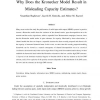Free Online Productivity Tools
i2Speak
i2Symbol
i2OCR
iTex2Img
iWeb2Print
iWeb2Shot
i2Type
iPdf2Split
iPdf2Merge
i2Bopomofo
i2Arabic
i2Style
i2Image
i2PDF
iLatex2Rtf
Sci2ools
TIT
2010
2010
Why does the Kronecker model result in misleading capacity estimates?
Many recent works that study the performance of multi-input multi-output (MIMO) systems in practice assume a Kronecker model where the variances of the channel entries, upon decomposition on to the transmit and the receive eigen-bases, admit a separable form. Measurement campaigns, however, show that the Kronecker model results in poor estimates for capacity. Motivated by these observations, a channel model that does not impose a separable structure has been recently proposed and shown to fit the capacity of measured channels better. In this work, we show that this recently proposed modeling framework can be viewed as a natural consequence of channel decomposition on to its canonical coordinates, the transmit and/or the receive eigen-bases. Using tools from random matrix theory, we then establish the theoretical basis behind the Kronecker mismatch at the low- and the high-SNR extremes: 1) Sparsity of the dominant statistical degrees of freedom (DoF) in the true channel at the low-SNR ...
| Added | 22 May 2011 |
| Updated | 22 May 2011 |
| Type | Journal |
| Year | 2010 |
| Where | TIT |
| Authors | Vasanthan Raghavan, Jayesh H. Kotecha, Akbar M. Sayeed |
Comments (0)

